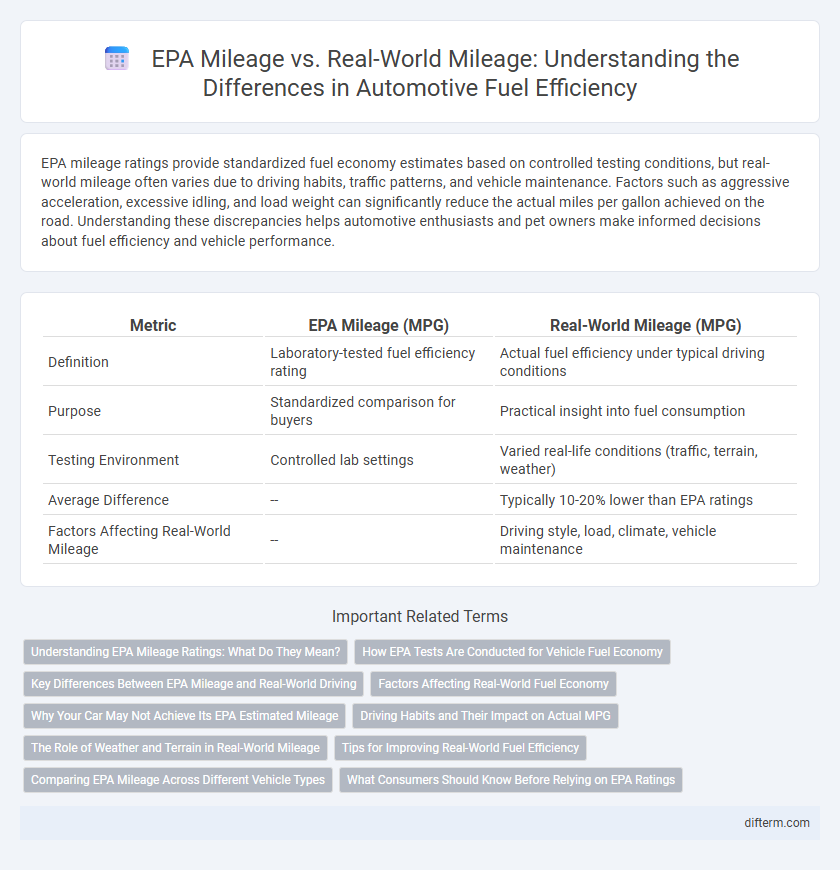EPA mileage ratings provide standardized fuel economy estimates based on controlled testing conditions, but real-world mileage often varies due to driving habits, traffic patterns, and vehicle maintenance. Factors such as aggressive acceleration, excessive idling, and load weight can significantly reduce the actual miles per gallon achieved on the road. Understanding these discrepancies helps automotive enthusiasts and pet owners make informed decisions about fuel efficiency and vehicle performance.
Table of Comparison
| Metric | EPA Mileage (MPG) | Real-World Mileage (MPG) |
|---|---|---|
| Definition | Laboratory-tested fuel efficiency rating | Actual fuel efficiency under typical driving conditions |
| Purpose | Standardized comparison for buyers | Practical insight into fuel consumption |
| Testing Environment | Controlled lab settings | Varied real-life conditions (traffic, terrain, weather) |
| Average Difference | -- | Typically 10-20% lower than EPA ratings |
| Factors Affecting Real-World Mileage | -- | Driving style, load, climate, vehicle maintenance |
Understanding EPA Mileage Ratings: What Do They Mean?
EPA mileage ratings provide standardized fuel efficiency estimates based on controlled laboratory tests using predefined driving cycles, such as city and highway conditions. Real-world mileage often differs due to variables like driving habits, traffic conditions, vehicle maintenance, and environmental factors that affect fuel consumption. Understanding the distinction helps consumers set realistic expectations and make informed decisions when comparing automotive fuel economy.
How EPA Tests Are Conducted for Vehicle Fuel Economy
EPA vehicle fuel economy tests are conducted under controlled laboratory conditions using a dynamometer that simulates driving cycles such as city and highway driving. These standardized tests measure exhaust emissions and fuel consumption at specific speeds and accelerations to estimate miles per gallon (MPG) ratings. Factors like temperature, road conditions, and driver behavior are excluded, which often results in EPA mileage ratings differing from real-world fuel economy.
Key Differences Between EPA Mileage and Real-World Driving
EPA mileage estimates are derived from standardized laboratory tests simulating ideal driving conditions, which often result in higher fuel efficiency ratings than typical usage. Real-world mileage accounts for variables such as traffic, driving habits, terrain, and weather, leading to lower and more variable fuel economy. Understanding these differences helps consumers set accurate expectations and make informed automotive purchasing decisions.
Factors Affecting Real-World Fuel Economy
Real-world fuel economy often differs from EPA mileage due to factors such as driving habits, traffic conditions, and vehicle maintenance. Variables like aggressive acceleration, heavy loads, and use of air conditioning can significantly reduce actual fuel efficiency. Road type and terrain, along with weather conditions, also play crucial roles in how closely real-world mileage matches EPA estimates.
Why Your Car May Not Achieve Its EPA Estimated Mileage
EPA mileage estimates are derived from standardized laboratory tests that simulate driving conditions but cannot fully replicate real-world scenarios such as variable traffic, weather, and driving habits. Factors like aggressive acceleration, frequent idling, and use of air conditioning significantly reduce actual fuel efficiency compared to EPA ratings. Tire pressure, vehicle maintenance, and payload also influence fuel consumption, causing discrepancies between EPA estimates and on-road mileage.
Driving Habits and Their Impact on Actual MPG
Driving habits significantly influence real-world mileage, often causing discrepancies between EPA ratings and actual MPG. Aggressive acceleration, harsh braking, and high-speed driving can reduce fuel efficiency by up to 30%, compared to EPA estimates based on standardized tests. Maintaining steady speeds, avoiding rapid accelerations, and reducing idling time help maximize fuel economy closer to EPA-rated mileage in everyday driving conditions.
The Role of Weather and Terrain in Real-World Mileage
Weather conditions such as extreme temperatures and heavy rain significantly impact real-world automotive mileage by increasing fuel consumption compared to EPA estimates. Terrain variations, including hilly or mountainous roads, demand more engine power, reducing vehicle efficiency beyond standardized EPA test cycles. Understanding these environmental factors is essential for accurate predictions of real-world fuel economy and better trip planning.
Tips for Improving Real-World Fuel Efficiency
Real-world fuel efficiency often falls short of EPA mileage estimates due to driving habits, traffic conditions, and vehicle maintenance. To improve fuel economy, maintain proper tire pressure, reduce excessive idling, and avoid aggressive acceleration or heavy loads. Regular engine tune-ups and using the recommended motor oil can also enhance overall fuel performance and help achieve mileage closer to EPA ratings.
Comparing EPA Mileage Across Different Vehicle Types
EPA mileage ratings offer standardized fuel efficiency estimates, but real-world mileage often varies significantly depending on vehicle type, driving conditions, and maintenance. Compact cars and hybrids generally show closer alignment between EPA estimates and actual mileage due to their optimized aerodynamics and advanced powertrains, while trucks and SUVs tend to have wider gaps attributed to heavier weights and variable load factors. Understanding these discrepancies helps consumers make informed decisions by comparing EPA figures with user-reported data and specific use-case scenarios.
What Consumers Should Know Before Relying on EPA Ratings
EPA mileage ratings provide standardized fuel economy estimates based on laboratory tests under controlled conditions, but real-world mileage often varies due to factors such as driving habits, terrain, weather, and vehicle maintenance. Consumers should recognize that EPA figures serve as comparative benchmarks rather than exact predictions, emphasizing the importance of user reviews and personal driving patterns when assessing fuel efficiency. Understanding the limitations of EPA ratings helps buyers make informed decisions by considering additional real-world data sources and individual usage scenarios.
EPA mileage vs real-world mileage Infographic

 difterm.com
difterm.com